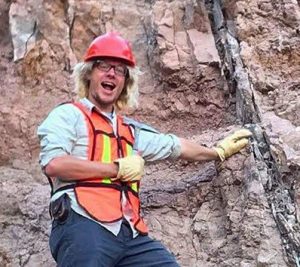Kinematic Analysis of Neogene and Quaternary Faults in the Santa Rosalia Basin along the Margin of the Gulf of California, Baja California Sur, Mexico

Luke Johnson
Advisor: Dr. Dave Kimbrough
Friday May 4th, 2018
CSL 422 – 11:40 to noon
watch Luke’s defense
Abstract
Late Cenozoic volcanic and sedimentary rocks of Santa Rosalía basin located on the western shore of the Gulf of California in central Baja California Sur, México contain an important kinematic record associated with continental rifting and the transfer of Baja California crust from the North American to Pacific plates. This study identifies fault types and orientations and differs from previous investigations by taking advantage of excellent new exposures created by Minera Boleo mining operations. Faults cutting volcanic rocks were measured in arroyo outcrops but most measurements were collected from mine cuts. Fault rocks including fault gouge and breccia were sampled and analyzed by petrographic, X-ray diffraction, and Scanning electron microscopy methods. Analysis document mineralization of sepiolite, a soft white clay mineral, along shear zones. We collected orientation data on over 250 faults and slickenlines in multiple unconformity bounded formations in the Santa Rosalía basin. Fault orientation data were processed in QGIS, Microsoft Excel, Stereonet 9, and Fault Kin 7. Most faults are oblique faults with a normal component of slip; very few thrust faults were found. The data from successive formations in the basin reveal temporal changes in fault orientations and slip directions. Middle to Late Miocene volcanic rocks are dominated by steep to moderately dipping NW- to N-striking faults that dip dominantly SW or are very high angle, with moderately-plunging slickenlines. Late Miocene sedimentary rocks (Boleo Formation) are dominated by steeply-dipping, NNW- to NNE-striking oblique-slip faults, with a wide range in plunge of slickenlines. Pliocene sedimentary rocks (Tirabuzón and Infierno Formations) faults are dominated by steeply-dipping, NW- and NE-striking faults with dominant normal displacement determined from stratigraphic offset and steep plunge in striations. Quaternary marine terraces are cut by steeply-dipping, NW to NE-striking faults with no preserved slickenlines found. The changes in fault orientations mark a shift in stress conditions during the complex tectonic process of the rifting of the Baja California Peninsula.

